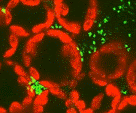Plant Pathology Department
ORCID IDs
Document Type
Article
Date of this Version
2012
Citation
Published in Journal of General Plant Pathology 78 (2012), pp. 85-98; doi: 10.1007/s10327-012-0361-2
Abstract
Web blight, an important foliar disease of dry beans in the Americas, is a challenge to manage. We studied genetic variation of 92 isolates of Rhizoctonia solani subgroups AG-1-IE and AG-1-IF using DNA fingerprinting methods and mycelial compatibility grouping. The isolates were collected over 13 years from bean fields in the Dominican Republic, Honduras and Puerto Rico. Cluster and AMOVA analysis of combined data from two universal rice primers and two internal sequence repeats revealed significant genetic variation among and within populations of both subgroups. Variation was influenced by geographic origin and sampling year for AG-1-IE isolates and geographic origin for AG-1-IF isolates. Mycelial compatibility of paired isolates was mostly scored as incompatible in both subgroups and supported many unique phenotypes. Only two isolates of AG-1-IE displayed mycelial compatibility and DNA fingerprints, suggesting clonal origin. Genetic variation in these AG-1-IE and AG-1-IF isolate populations may explain the lack of durable resistance to web blight reported in dry beans.



Comments
Copyright © 2012 The Phytopathological Society of Japan and Springer Verlag. Used by permission.